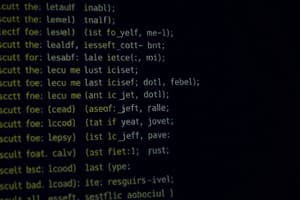Podcast
Questions and Answers
Python uses ______ to denote multi-line comments, allowing developers to comment out blocks of text.
Python uses ______ to denote multi-line comments, allowing developers to comment out blocks of text.
triple quotes
Variable names in Python must start with a letter or an ______ and can contain letters, numbers, and underscores.
Variable names in Python must start with a letter or an ______ and can contain letters, numbers, and underscores.
underscore
In Python, the ability for variables to change types without explicit declarations is referred to as ______ typing.
In Python, the ability for variables to change types without explicit declarations is referred to as ______ typing.
dynamic
The ______ statement provides an alternative block of code that executes if the previous if condition is false.
The ______ statement provides an alternative block of code that executes if the previous if condition is false.
Python supports multiple ______ in a single line, allowing for concise and efficient variable assignment.
Python supports multiple ______ in a single line, allowing for concise and efficient variable assignment.
The ______ loop continues running as long as the condition remains true.
The ______ loop continues running as long as the condition remains true.
In Python, the ______ statement is used to immediately exit from a loop.
In Python, the ______ statement is used to immediately exit from a loop.
Python has a variety of ______ functions that are optimized for performance and reliability.
Python has a variety of ______ functions that are optimized for performance and reliability.
A user-defined function in Python can make your code more ______ by performing specific tasks.
A user-defined function in Python can make your code more ______ by performing specific tasks.
The ______ statement is used in functions to send a result back to the caller.
The ______ statement is used in functions to send a result back to the caller.
Flashcards are hidden until you start studying
Study Notes
Multi-Line Comments in Python
- Multi-line comments can be created with triple quotes (
'''or"""). - Typically used for documentation strings (docstrings) rather than comments.
Variables in Python
-
Variable Naming Rules
- Identifiers must start with a letter or underscore; can include letters, numbers, and underscores.
- Avoid using reserved keywords like
class,try, andreturnfor variable names. - Follow conventions like
snake_casefor improved readability.
-
Dynamic Typing
- Variables can change types without explicit declarations, enhancing flexibility.
- Requires careful management to avoid type-related errors.
-
Variable Assignment
- Python infers variable types during assignment.
-
Multiple Assignments
- Supports assigning values to multiple variables in a single line for concise code.
-
Type Casting
- Built-in functions like
int(),float(), andstr()allow conversion between data types, essential for user input and calculations.
- Built-in functions like
Control Structures: Conditional Statements
- If Statements
- Basic if statement executes a block of code if the condition (e.g.,
x > 0) is true. - Else provides an alternative block if the if condition is false.
- Elif checks additional conditions if the previous if condition is false, facilitating multiple condition checks.
- Nested if statements add complexity by allowing if statements within other if statements.
- Basic if statement executes a block of code if the condition (e.g.,
Control Structures: Loops
-
For Loop
- Iterates over a sequence (like a list or range) for repetitive tasks, facilitating operations on collections.
-
While Loop
- Continues execution as long as the condition is true, suited for situations where the iteration count is unknown (e.g., user input).
-
Break Statement
- Exits the loop immediately, skipping remaining iterations.
Functions in Python
-
Types of Functions
- Built-in functions (e.g.,
print(),len(),type()) simplify common tasks, providing performance and reliability. - User-defined functions allow customization and modularity for specific tasks.
- Built-in functions (e.g.,
-
Defining and Calling Functions
- Functions are defined with the
defkeyword and execute their bodies when called.
- Functions are defined with the
-
Parameters and Arguments
- Functions can take parameters to personalize actions, enhancing functionality.
-
Return Statement
- Returns results from a function, crucial for calculations and data passage back to the main program.
-
Multiple Return Values
- Functions can return multiple values, which can be unpacked and utilized independently.
-
Lambda Functions
- Small, anonymous functions defined with the
lambdakeyword, capable of accepting multiple arguments but executing a single expression.
- Small, anonymous functions defined with the
Object-Oriented Programming (OOP) in Python
-
OOP uses objects to represent real-world entities, encapsulating data and behavior for modular, reusable code.
-
Classes and Objects
- A class acts as a blueprint for objects, defining their attributes and methods.
-
Inheritance
- Allows classes to inherit from parent classes, acquiring their attributes and methods.
-
Polymorphism
- Enables classes to utilize methods from parent classes in their own unique contexts.
Modules and Packages
- A module is a file containing Python definitions and statements, aiding in code organization.
- Any
.pyfile can function as a module, enhancing maintainability and reusability. - Example: A file named
mymodule.pycould define a functiongreet(), which could be imported and reused in other programs.
Studying That Suits You
Use AI to generate personalized quizzes and flashcards to suit your learning preferences.




